Abstract
The aim of the study is to learn about typological peculiarities of frequency and duration of change of saccadic fixation on certain elements of the visual field as distinctive markers of selective thinking. The sample of the research includes 69 participants from 21 to 23 years old. It was revealed that the saccade latency has sufficient variability to use this index as a criterion for the division of the sample into three groups. The comparison of the representatives of the three groups using other indicators of oculomotor activity demonstrated a statistically significant relationship between the key areas of the visual task and the rate of saccade latency. It was found that the participants who couldn't solve the task correctly are characterized by longer fixation on certain elements of the visual field in the process of solving the task. The participants who were successful in solving the problem are characterized by short eye fixation at specific areas of the visual space and the optimal choice of the initial point of area inspection. The indicator of saccade latency average can be the basis for the classification of the types of solving of cognitive tasks.
Keywords: Selective ThinkingOculomotor ActivityCognitive Task
Introduction
Almost half a century ago, Gippenreyter (1978) stated that numerous studies of eye movements are carried out in psychology. According to the author, these studies can be divided into two broad categories. The first category includes the studies where eye movements serve as research subject, because they discuss different types of quantitative and functional characteristics, as well as physiological mechanisms of eye movements. The second category includes the works, where the analysis of eye movements is used as a method of investigation of other processes. This remark is primarily concerned with the processes of visual perception, the attempts to treat eye movements in the context of other activities, such as thinking, are less implemented. It is believed that today the study of eye movements is experiencing a new surge of research interest in psychology, psychophysiology and cognitive science. This interest was mostly initiated by technological breakthrough in the field of research methods. For example, actively developing technologies of eye tracking system (Filin, 2002; Frankl, 1990; Hayhoe & Ballard, 2005; Newell, Shaw & Simon, 1958; Zinchenko, 2006, etc.) allow to track and record peculiarities of oculomotor activity of the test person more accurately than the traditional methods (contact and non-contact, photoelectrical, electro-oculographical, etc.) (Vladimirov, 1972). Nowadays, we can say about simplification of statistical analysis of the data that fixate eyes direction, peculiarities of visual attention, the focus of attention and the duration of its fixation on the key elements of the visual field, etc.
Problem Statement
Progressive sophistication of the subject matter shows a change of ideals of rationality in the process of self-development. V.S. Stepin (2012) points out that classical, non-classical, post-nonclassical science involve different types of reflection on activities. These types of reflection move from the elimination of explanation of all the procedures that are not related to the object (classical), to understanding the characteristics of the object feature in relatedness to means and operations used in activities (non-classic), to understanding the value-orientation of the subject of scientific activity. "It is important that each of these levels of reflection and strategies correlate with system characteristics of objects and become the condition for their effective development (simple systems as the dominant object are discussed in classical science, complex self-regulating systems - in non-classical, complex self- developing - in post-nonclassical)" (Stepin, 2012).
The problem of eye movement from the perspective of different ideals of rationality.
In post-nonclassical paradigm, we consider the eye and "oculomotor activity" to be much more complicated than under the earlier paradigms (classical and non-classical). Classical psychology that is based on binary thinking clearly separates external and internal, subjective and objective and does not allow not only to solve, but even to set up the problem of selectivity of mental reflection. The eye is considered to be here as one of the "holes" through which sense data "pour into the bucket" (the brain, consciousness) for further processing. Karl Popper stated ironically that “«the buckety theory of the mind» is a standard theory of knowledge from Aristotle to some of my contemporaries, such as Bertrand Russell, the great evolutionist John. B.S. Haldaneand or Rudolf Carnap. This theory is shared by the first counter too” (Popper, 2000).
Over the time, the problem of the place and the role of psychic in the structure of mental mechanism of selectivity and activity of consciousness will be the "touchstone" which will test explanatory power of theories, expressing different ideals of rationality (Klochko, 2007; 2011).
The non-classical psychology, that began to overcome the confrontation between matter and spirit, mental and physical, subjective and objective, gave the sense organs and the eye in particular the function of «filter». V. Frankl, for example, no longer separates the body from «whole organism». Each organ choses just the only fragment from the world, but these fragments form human environment: each of them "is selected from the entire wealth of the world" (Frankl, 1990).
We agree with the V.P. Zinchenko (2006) that "from existing post-nonclassical perspectives emphasizing interdisciplinarity of modern science during construction of models in which different areas of knowledge are synthesized, L. S. Vygotsky was a classic of post-nonclassical science " (Zinchenko, 2006, p.102). For example, L.S. Vygotsky's post-nonclassical ideas are expressed in the definition: "If the eye would have seen everything, it didn't not see anything." The scale of the problem has changed dramatically. Now the whole psyche is presented in a new way: it is discussed as "a sieve that strains the world and changes it in a way to act''. This is its positive role - not to reflect (reflects and non-psyche; the thermometer is more accurate than sensation), but to reflect in a wrong way that is subjectively distort the reality in favour of the body (Vygotsky, 1982, p. 347). This "subjective distortion of reality" is the "semantic field" - the reality that is much more complex than the "optical field".
By means of creative development of Vygotsky's ideas, Tikhomirov (1965) saw the function of psyche in the "generation of new reality" that is not synonymous with the process of "construction of reality" which is exactly identical to the process of "constructing of knowledge" from the position of modern radical constructivists. J.Piaget, P. Watzlawick, E. von Glasersfeld spoke about the construction of reality in the consiousness of the subject, the observer. Tikhomirov (1965) points out that the space of mental activity itself is multi-dimensional, it includes both objectively given structure which can be described by means of formal logic and dynamic informal (value-semantic) structure. In the paper "The Principle of Selectivity of Thinking," published in 1965 (Tikhomirov, 1965) it was suggested, that the essence of selective processes of thinking is connected with the semantic organization of situation. Taking into consideration that meanings are read by emotions, allowing them to fulfil their coordinating role (Tikhomirov & Klochko, 1980), we are dealing with complex mechanism of selection that constitutes fundamental difference from all the known natural mechanisms of this kind. At the time, cybernetics started the introduction of special rules of reducing search to electronic machines. Nevertheless they still had to look in the direction of psychology to find out how this "device" works with a human. Psychologists faced the most important psychological problem, the solution of which leads to a revision of the functional role of psyche, its mission and purpose. The main difference between man and machine are the forms of reflection of problematic situation: person's thinking is regulated with "informal (value-semantic) structure of the situation", and as for the machine structure, it stays formal logical. This fact indicates the difference in the mechanism of selectivity between man and machine; the person's mechanism has completely different nature (and can hardly be modelled by a computer) (Tikhomirov, 1965).
Research Questions
We can assume that there are types of people who are more oriented to formal-logical procedure, and those who are oriented to meaningful measurement of situations in which they search for solutions of the problems. Realizing that, in this case we refer to the idea of preserving the unity between them («the principle of unity of affect and intellect» speaks about it); you can still believe that there is a certain kind of personality predisposition as a willingness to rely on formal logic or semantic foundation in the process of solving of cognitive tasks. To test this hypothesis, we developed a special technique. The basis of this technique is a verbal and logical cognitive task, the conditions of the task were presented in a certain way in visual field, which makes it possible to connect eye-tracking that fixate eye movements during pointing out the elements that make sense for the formulation and solution of cognitive task. It helped us to differentiate between the propensities to use cognitive logic or semantic foundations in cognitive activity.
Purpose of the Study
The purpose of this work does not include the preliminary analysis of the existing research in the field of eye-tracking. The aim of the present study is to reveal the idea that strategically there are two open ways for the modern psychologists to use new powerful research technologies in modern science. One way is to use these technologies to address the problems that were formulated earlier and to expand the problem field which they form. Another strategy is to use new technologies to expand the subject field of science by setting new objectives that are influenced with modern tendencies of the development of subject matter as a self-developing system.
Research Methods
During the experiment, the participants were asked to solve the problem "Swahili". They were required to translate the phrase into "Swahili" language using the translation of similar phrases ( Figure
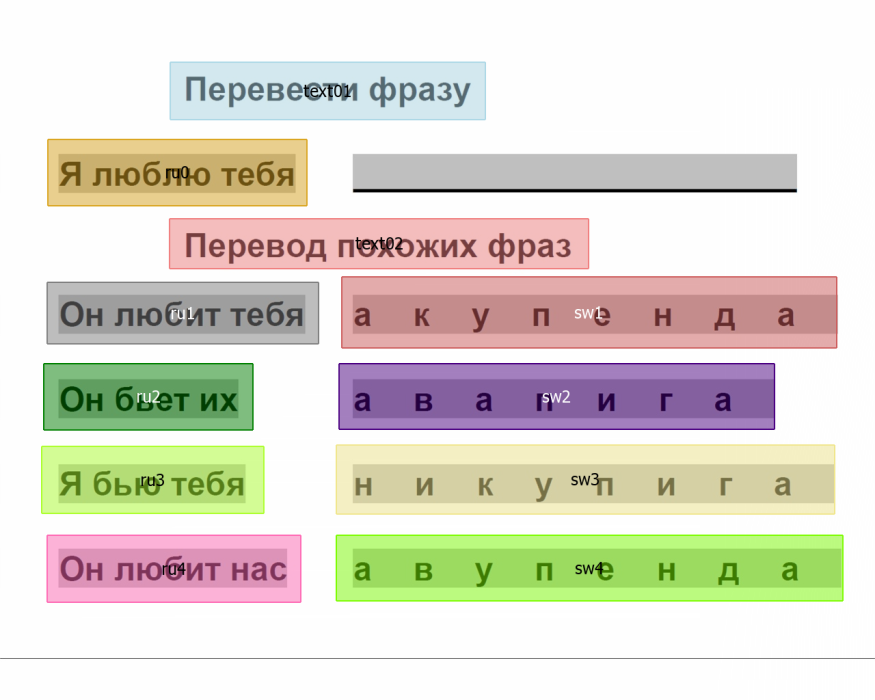
To register the indicators of oculomotor activity of participants while they were solving the problem we divided the stimulus material into 11 key visual areas, 2 of them referred to instructions and 9 areas to the condition of the problem (each area accounted for the single phrase).
The experiment was conducted using apparatus methods of diagnostics; as follows the technology of registration of eye movements by means of a mobile eye-tracking system in the form of eye glasses SMI Eye Tracking Glasses (ETG). The frequency of binocular survey was 30 Hz, we also used a laptop with the software SMI Experiment Suite 360 ° and iView ETG v. 2.0.1. The data of oculomotor activity was recorded in the program SMI BeGaze 3.4 (module Event Statistics), their processing is performed by means of statistics packages of IBM SPSS v. 19 and StatSoft Statistica v. 6.1 Ru. Methods of descriptive statistics and correlation analysis of r-Spirmen were applied. Recording was carried out with a frequency (sampling rate) of 30 Hz, the accuracy of the estimated 40 entries computed from 92.63 to 99.98%. Calibration area is 1280 * 960. We did recording for both eyes (binocular). The experiment was conducted in a brightly lit experimental room, with a constantly maintained level of illumination. The place for the experiment was equipped with individual table for experimenter and the participant, there was also a partition of 40 sm in height in the room.
Participants
The sample of the research included 69 participants - students of Psychology Department of Tomsk State University.
We formed three groups of participants: Group 1 - the subjects who have short saccade latency during solving of visual problems, Group 2 - the respondents who have average saccade latency and Group 3 - the participants who have long saccade latency. The distribution of the participants into the groups was based on calculation of quartiles.
Procedure
The experimental procedure began with attaching the recording device on the head of the participant, and then the participant was asked to sit down to table in the experimental room. The participant was instructed to take the most comfortable position for writing, but in a way that it was possible to record the eye movements while solving the task. Before the procedure began, the subject was provided with the consent form and the terms of participation in the experiment. Among the key points were: during the experiment the special equipment will be fixing and recording his/her eye movements; the participant may withdraw from participation at any time, without explaining the reasons. After the completion of the informed consent, the participant was asked to sit and get ready for the experiment. There was a pen, clean sheets and the sheet with the task prepared on the table. The ETG glasses were attached to the head of the participant, 3-point calibration was carried out to establish the correspondence between the position of the eye and the point of view. Then the participant took part in calibration process to reach maximum accuracy in recording of oculomotor activity. We used 3-point calibration, after that the device was ready for recording.
Diagnostic units
We identified the following diagnostic units for the analysis of eye-tracking in the study of subject's oculomotor activity during solving of cognitive problems:
Selection of the starting point of visual inspection of the space - Sequence (it is a serial number of the view focused on the area of interest (AOI).
The frequency rate of eye visits of key areas - Revisits
The density of view - time duration of view fixation on the visually determined fields of the task. This parameter is determined by four variables (see Table
1 ).
4. Saccade latency average - total saccade latency for all saccades / saccade count
All indicators (except Saccade latency average) were recorded separately for each selected area of interest (AOI) of the proposed problem. Areas matched phrases of the stimulus material.
The saccades are rapid, strictly coordinated eyes movements that occur at the same time and in the same direction. They are the main parameters of oculomotor activity, saying about the visual perception, goal-directed behaviour and inspection of the surrounding objects, in particular cognitive processes that arise during solution of visual tasks. In particular, saccadic eye movements direct view to the essential elements of the visual field. Each person can be characterized by individual pattern of saccades sequence, that is defined by three parameters: the interval between saccades, their amplitude and orientation. The parameters of saccades are modulated depending on the external and internal conditions (V. A. Filin). We used this parameter to introduce a typology of oculomotor activity during solving of cognitive task because the interval between saccades of the three parameters changed to a lesser extent, we also selected it as the grouping variable.
Findings
These data allow us to speak about observed trend of successful solutions due to the magnitude of the cognitive task with volume of saccade latency `(Fig. 02). Saccade latency is understood as the time between the end of a saccade and the start of the next saccade. The participants who submitted the correct answer to the proposed task, are characterized by medium or short saccade latency, it says about brief fixation on a single area and passing glance within perceived visual field. At that time, the participants who didn't solve the task, had a medium or long saccade latency in the process of visual perception of the elements of the visual field, in contrast, it says about longer fixation of view at the key elements of the visual field.
The results of the success of solving the proposed cognitive task by the participants of three selected groups are presented in Table
The comparison of the index «Sequence».
The comparative analysis of the results received in groups of participants with different saccade latency didn't show any statistically significant differences in the value of the index of «Sequence» for any of the selected areas of stimulus material (p ≤ 0.05). It says about no difference in the choice of the initial point of visual inspection of space by the respondents of three groups. Thus, we can assume that the value of the saccade latency has nothing to do with the choice of the initial point of visual inspection of the space. When comparing this index between the participants who solved the task and those who didn't solve it, we were able to identify statistically significant differences (U = 31.5; p = 0.039) for one of the nine selected areas (phrases) of visual space. This area (ru3) can be called "original" to find the right solution of the proposed task, as it points to the beginning of the encoded translation of the language "Swahili." According to the received data, this area became the starting point of visual inspection of the space for the majority of the participants who solved the task correctly.
The comparison of the index «Revisits».
As a result of the comparative analysis of visit rates to 9 selected key areas of visual task by the participants with various saccade latency, we were able to establish statistically significant differences (F = 3.735; p = 0.042) concerning visit rate to one of the areas (sw2). According to this information, the participants who have short saccade latency while solving the proposed task visited this area more frequently than the participants of two other groups (Figure
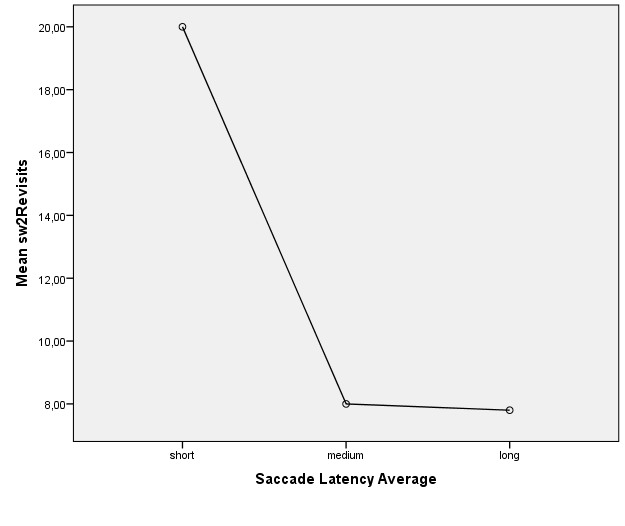
At the level of statistical tendency (p = 0.09) we found out the differences in the visit rate to the visual field (sw2) of the participants who solved the task and those who didn't. The participants who solved this task visited this area more often than those who didn't solve it.
The comparison of the index «Dwell Time»
When comparing the duration of all the fixations and saccades (attributed to each visual area) of the participants with different saccade latency we were able to reveal statistically significant differences between groups (F = 3.987; p = 0.035) for one (ru2) from 9 areas. The received data show that the participants with long saccade latency have longer fixations and saccades in this visual field than the participants with short and medium saccade latency (Figure
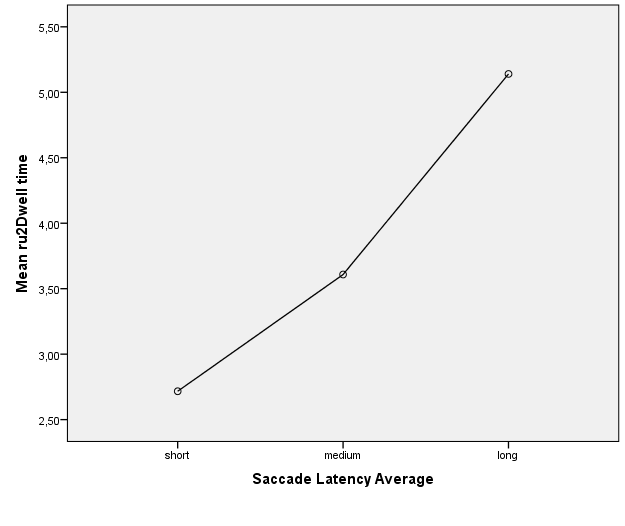
At the level of statistical tendency (p = 0.059) we were able to find out the differences in the value of the index «Dwell Time» for one visual field (sw3) between the participants who solved the task and those who didn't. The duration of all fixations and saccades (attributed to this area), of the participants who didn't solve the task was significantly higher than the index of the participants who gave the right answer. These data allows us to suggest that the majority of the participants who didn't solve the task, "thought in the right direction", as their elective oculomotor activity was focused for a long time precisely on the area where the encrypted translation of the beginning of the phrase to "Swahili " language was.
The comparison of the index «Average Fixation»
The comparative analysis of the results of three groups of participants who have different saccade latency show statistically significant differences in the average duration of fixations of two visual areas (ru3 and sw3) and differences in the level of statistical tendency in relation to three other areas: ru2, ru4 and sw1 (see table
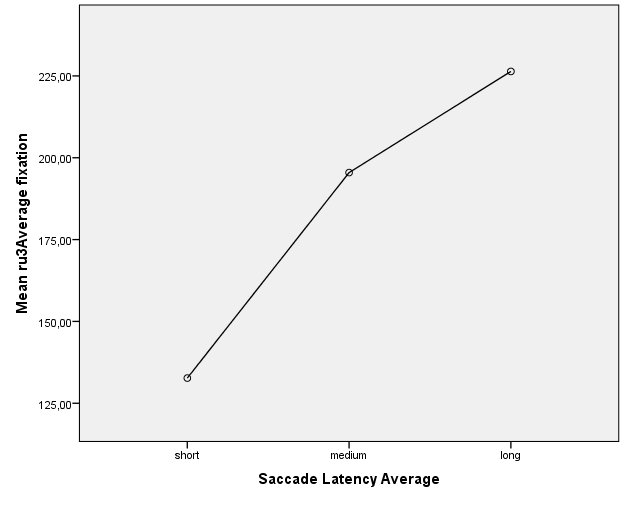
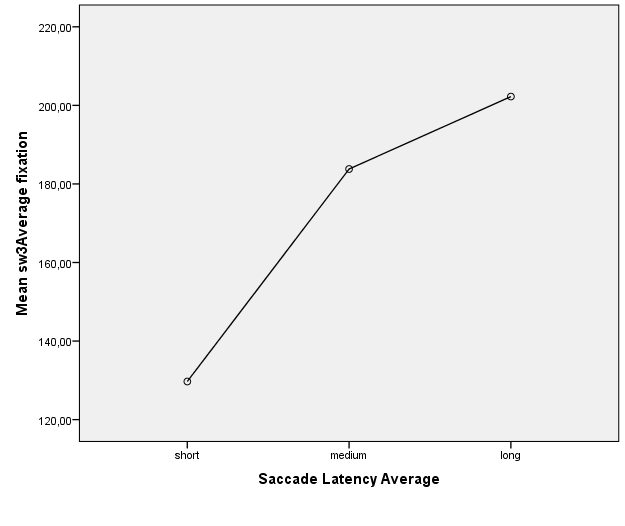
According to the data, the participants who have long saccade latency focus their eyes on two regions 2 (ru3, sw3) for longer time, these regions are the initial point for the successful solution of the proposed problem. As follows, they point to the start of the translation of the phrase into"Swahili" language. We didn't find any statistically significant differences in the average duration of fixation, relating to different visual areas of participants who solved the task and those who didn't. It can be assumed that the successful solution of cognitive tasks does not directly depend on the duration of fixations in key visual areas.
The comparison of index «First fixation».
When comparing the time from the start of the stimulus presentation to its first fixation by the participants characterized by different saccade latency we were able to identify the differences at a high level of statistical significance (F = 6.143; p = 0.008) for the same key area (sw3), which is the starting point for the task (the decoding of the phrase starts here). According to information received the time from the beginning of stimulus presentation to the first view fixation of the participants on this area increases together with increasing of their average saccade latency (Figure
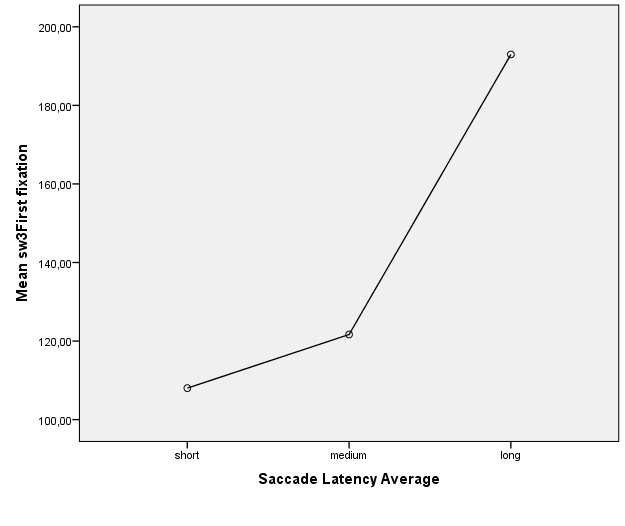
We found no statistically significant differences of index «First fixation» in any of 9 visual areas between the participants who solved the task and those who didn't. Accordingly, we can assume that the successful solutions of cognitive problems are not directly dependent on the start of stimulus presentation to the first fixation of eyes.
The Comparison of index «Fixation count»
As a result of comparative analysis of the number of fixations within each selected area and between groups of participants with different saccade latency and participants who solved the task and those who didn't we identified no difference. Thus, we can assume that the successful solution of cognitive problems does not directly depend on the number of fixations of respondents in key areas of the visual field.
Conclusion
The study of the peculiarities of oculomotor activity of participants who demonstrated various success in solving cognitive task, allowed us to make the following conclusions:
The participants who couldn't solve the task correctly are characterized by low frequency of saccades change and longer fixation on certain elements of the visual field in the process of solving the task. It says about longer concentration of their visual attention on specific problem areas and search for possible solutions of cognitive task.
In contrary, the participants who were successful in solving the problem are characterized by rapid saccades change and short eye fixation at specific areas of the visual space and the optimal choice of the initial point of area inspection. This fact allows us to speak about the participants' ability to hold within the field of visual attention a big visual space, it also may say about high speed of their mental processes and productive thinking.
As part of the research we made an attempt to introduce a typology describing the oculomotor activity of participants during solving of cognitive problem. We chose participants' arbitrary saccadic movements or the indicator of average saccade latency as the basis of the typology. As a result, we were able to identify three types that are characterized by the following features of oculomotor activity:
Typological features of solving of cognitive tasks
First type is characterized by short saccade latency, short period of time from the start of stimulus presentation to the first fixation on the key field of vision (the starting point for understanding and solving the problem), short duration of fixations on all the elements of the visual field. These participants are characterized by uniform distribution of the duration of fixations and saccades in all key areas of the visual field. The participants who have short saccade latency are characterized by the ability to solve cognitive tasks (more than 80% of the participants of this group solved the proposed task) due to a harmonious combination of semantic and logical processing of the problem.
Second type is characterized by medium saccade latency, average time from the beginning of stimulus presentation to the first fixation on the key elements of the visual perception (the starting point for understanding and solving the problem). This group of participants are characterized by long view fixation on all the elements of the visual field. Moreover, they are characterized by approximately the same length of all fixations and saccades falling on each key area of visual perception, which is also typical for the first type. Among the respondents, who demonstrated the oculomotor activity with medium saccade latency, we can meet the equal proportions of participants with different abilities to solving cognitive task, but the common feature for all of them is «fixedness» on the elements of the situation that have significant meaning.
Third type is characterized by long saccade latency, longer period of time from the start of stimulus presentation to the first fixation on the key areas of visual field (the starting point for understanding and solving the problem) and much longer (in comparison with the other two types) fixation period on all the elements of visual perception. At the same time the duration of all fixations and saccades, relating to the key areas of visual field, is different for this type of the test. Their maximum duration occurs on the problem elements of visual perception (in terms of solving the problem). Otherwise, they eyes «got stuck» in these areas. The most part of the participants, who have long saccade latency, experience some difficulties in solving cognitive tasks (60% of the participants of this group were not able to solve the problem). It happened because of minimization of orientation on the elements of situation that has actual meaning for the solution.
Thus, this study revealed typological features of the frequency of saccade change and duration of view fixation on certain elements of the visual field in the process of solving cognitive tasks. It allows us to present them as unique markers of selective thinking, which occurs in the readiness to give preference to formal logical or semantic foundations in the situation of «profound mental work [5].
This study can be perceived as a pilot study, oriented to identification of prospects and strategies for future research aimed at identifying sustainable patterns of selectivity of thinking in solving of cognitive tasks.
References
- Filin, V.A. (2002). Avtomatya saccad [Automatism of saccades]. Moscow, MSU. [In Russian]
- Frankl, V. (1990). Chelovek v poiskah smysla [Man in search of meaning]. M, Progress Publisher. [In Russian]
- Gippenreyter, Y.B. (1978). Dvizheniya chelovecheskogo glaza [Movement of the human eye]. Moscow State University Press. [In Russian]
- Hayhoe, M., Ballard, D. (2005). Eye movements in natural behaviour// TRENDS in Cognitive Sciences, Vol.9, No.4.
- Klochko, V.E. (2007). Zakonomernosty dvizheniya psyhologicheskogo poznanyia i problem metoda nauki [The Laws of motion of psychological knowledge and the problem of scientific method]. Metodologiya i Istorya Psyhologii, 2, № 1, 5-19. [In Russian]
- Klochko, V.E. (2011). Evolucia psyhologicheskogo myshleniya: etapy razvitiya i zakonomernosti uslozhneniya [The evolution of psychological thinking: development stages and patterns of complication]. Siberian Psychological Journal, 40, 136-151. [In Russian]
- Newell, A., Shaw, I.C. and Simon, H.A. (1958). Chess Playing Programs & Problem of Complexity.
- Popper, K.R. (2000). Evolutionary epistemology. Evolutionary epistemology and the logic of the social sciences: Karl Popper and his critics. M. Editorial URSS. Retrieved from: http://www.evolkov.net/PopperK/Evolution.Epistemol.&.SocSciences/index.html
- Stepin,V.S (2012). Samorazvivayushiesya systemy i postneklassicheskaya razionalnost [Self-developing systems and postnonclassical rationality]. Retrieved from: http://filosof.historic.ru/books/c0026_1.shtml [In Russian]
- Tikhomirov, O.K. (1965). Principy izbiratelnogo myshleniya [The principles of selective thinking]. Voprosy Psychologii, 6, 16-32. [In Russian]
- Tikhomirov, O.K., Klochko V.E. (1980). Emocionalnaya reguljazia myshlenia [Emotional regulation of thinking]. Voprosy Psychologii, 5, 23-31. [In Russian]
- Vladimirov, A.D. (1972). Metody issledovaniya dvizheniya glaz [Research methods of eye movement]. Moscow State University Press. [In Russian]
- Vygotsky, L.S. (1982). Sobranie sochineniy [Collected Edition]. Vol. 1 [In Russian]
- Zinchenko, V.P. (2006). Zhivye metafory smysla [Live metaphors of meaning]. Voprosy Psychologii, 5, 100-112. [In Russian]
Copyright information

This work is licensed under a Creative Commons Attribution-NonCommercial-NoDerivatives 4.0 International License.
About this article
Publication Date
23 November 2018
Article Doi
eBook ISBN
978-1-80296-048-8
Publisher
Future Academy
Volume
49
Print ISBN (optional)
-
Edition Number
1st Edition
Pages
1-840
Subjects
Educational psychology, child psychology, developmental psychology, cognitive psychology
Cite this article as:
Balanev, D. Y., Galazhinskiy, E. V., Vaulina, T. A., Krasnoryadtseva, O. M., Kulikov, I. A., & Shcheglova, E. A. (2018). Oculomotor Activity In The Structure Of The Mechanism Of Selective Thinking. In S. Malykh, & E. Nikulchev (Eds.), Psychology and Education - ICPE 2018, vol 49. European Proceedings of Social and Behavioural Sciences (pp. 92-105). Future Academy. https://doi.org/10.15405/epsbs.2018.11.02.11

